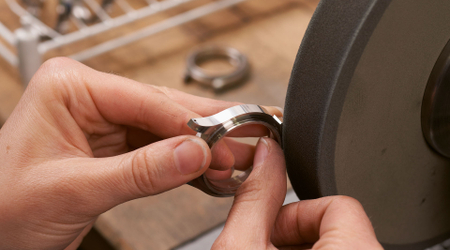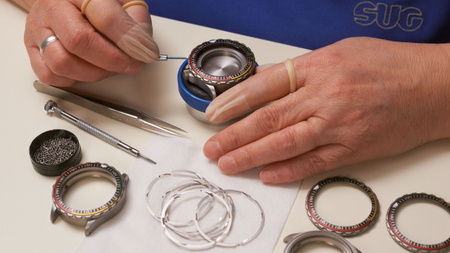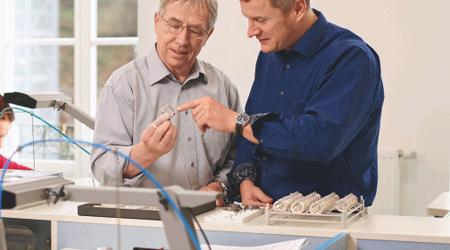Factory for high-tech watch cases
The move to independence
What factors led to the founding of SUG? Having worked for Glashütter Uhrenbetriebe, Ronald Boldt was also familiar with the suppliers of watch cases. He observed two things: that the market was relatively small and manageable, and that there was room for improvement in terms of production quality. Why not do it himself, he thought. In 1999, Ronald Boldt set out on the road to entrepreneurial freedom with two partners – one of which was Lothar Schmidt. As so often in life, this was the result of a fortunate coincidence: Ronald Boldt was looking for business partners to help establish a new company, while Lothar Schmidt was looking for a new supplier of high-quality watch cases for SINN. Since the two men had met before in the tight-knit horological community of Glashütte, they wasted no time in discussing their options. And so the cornerstone was laid.When a disastrous flood destroyed SUG’s premises in 2002, Lothar Schmidt acquired the shares of the third partner, further cementing the already successful partnership between Ronald Boldt and Lothar Schmidt. Today, Ronald Boldt regards the alliance as exemplary and views the business relationship as one which both sides continue to care about passionately. After all, both are engineers who speak the same language and who get along well – professionally and personally. Ronald Boldt has meanwhile left the company to enjoy his well-earned retirement. His son Daniel, who has been working for the company for years, has taken his place as sole managing director.

And so SUG has supplied SINN with watch cases ever since being founded. The small Saxon company has grown from its humble origins into one of the leading manufacturers in the field. In terms of finding and implementing the best solutions, SUG’s quality and production processes are on a technological par with those of the best manufacturers in the business – anywhere in Europe! This is evidenced by the list of renowned watchmakers that entrust their production secrets to SUG and commission the company to manufacture watch cases for them. SUG’s success is a monument to the outstanding expertise the company has accrued over the years, and to its proven ability to come up with unique solutions, again and again. Another advantage of the company is its ability to provide extremely flexible, start-to-finish manufacturing of small production runs in premium quality, including design, CNC machining, finishing and assembly. The result is a finished watch case assembled completely to the desired specifications. Being able to perform tasks other manufacturers would balk at requires not only experience, but also creativity and passion – all of which are in ample supply at SUG. The company has succeeded in taking even the most demanding watch case designs through to series production readiness. “We are not an easy act to follow,” says Ronald Boldt with pride.

In other words, there are no limits to what his employees can make. And SINN cases are distinguished by their typical characteristics. They comprise individual components such as push-pieces, crowns, bezels, seals, backs, screws and springs, and are three-dimensional structures made of stainless steel, titanium, gold or – in the case of SINN diver’s watches – submarine steel. That requires specially developed tools and technologies – and not only for the manufacturing process. Watch cases are also characterised by their need to meet both aesthetic and technological demands. Ronald Boldt describes it aptly: “Making a watch case requires you to be both a goldsmith and a toolmaker.” The first step in this symbiosis of workmanship involves creating a production-ready, photorealistic 3D design on the basis of the specifications. After fine-tuning and approving the design, Ronald Boldt prepares the sets of drawings for the individual components and the tools that will be used to complete the second step in the production process. “This is value creation in the truest sense of the word. You take a workpiece – a rod, disc or circular blank – and lathe and mill it to create the finished components.” The subsequent third step involves what he calls “artistic handiwork” – the finishing process, i.e. grinding and polishing the surface of the case. ”The results must be outstanding, because if they are not outstanding, they are rejected,” he says in reference to the extremely high quality standards that leave no room for compromise. Finally, the individual components are assembled to create the finished product. The completed cases are then tested for pressure and water resistance and sent to SINN. The next step in the process of creating a high-quality special watch is carried out in Frankfurt am Main. It involves not only assembling and installing the movement, dial, hands and strap/bracelet, but above all integrating the SINN technologies.
SINN cases – a creative challenge
Each SINN case is given an individual quality assurance number, making it a unique specimen that must be water-resistant and protect the sensitive interior workings from dust and impact after assembly. But there is an additional element involved which, according to Ronald Boldt, “presents an ongoing creative challenge.” He is referring to the fact that SUG also manufactures cases for the pilot’s and diver’s watches, i.e. models which SINN has specially developed for use by professionals. They feature such technologies as HYDRO, Special Oil, Ar-Dehumidifying Technology, DIAPAL, TEGIMENT and Magnetic Field Protection – as well as extras like captive bezels and high-pressure resistance. And all of these technical features that are so characteristic of SINN watches place enormous demands on the construction and manufacturing of the cases. There are no off-the-peg solutions to these difficult tasks. Which means the SUG staff must constantly be searching for new methods and approaches. “This is an area where SINN Spezialuhren lives up to its name – these are truly ‘special watches’,” says Ronald Boldt. Take the U2 diving watch, for example: what other manufacturer is called upon to make a watch case out of submarine steel, a material that is scarcely ever used for watches? And the case must be capable of integrating Ar-Dehumidifying Technology and Special Oil, and it must fulfil the stringent testing requirements of Germanischer Lloyd (now DNV) in terms of pressure resistance, temperature resistance and functionality.

The utmost precision is required when pressing in the sapphire crystal glass.
What makes a watch a “special watch”
It is therefore crucial for SINN watch cases to fulfil these technical demands. In addition to protecting the movement, the case also has to ensure smooth operation of the watch’s various technological features. And there is a further factor: the ideas behind the technologies are realised in two important steps, namely the engineering design at the drafting table and the actual production on the CNC machine. In other words, it is the cases made by SUG in collaboration with the SINN development engineers that make SINN watches “special watches”. “Many of the technologies in SINN watches are made possible by the special construction of the watch case,” explains Ronald Boldt. Magnetic Field Protection, for example, requires the use of special materials developed to provide the particular characteristics required by the case. Of course, he is not revealing what those traits are.

The development of the D3 System is a good example of the process from the initial concept by SINN engineers to series production of the case by SUG. This horological innovation creates a seamless seal by inserting the push-piece pins and crown shafts directly in a specially finished drill hole in the case (the name D3 comes from “direkt doppelt dichtend”, the German words for “direct double sealing”). The D3 System permits the crown and push-piece to be integrated in the case, providing reliable protection from lateral impact and the penetration of dust or moisture. “The D3 System is a simple and effective sealing method that is both reliable and easy to assemble and service. It provides a better seal because it has fewer transition points between the interior and the exterior. But actually realising and implementing this solution was a real challenge in terms of design and production,” Boldt explains.
During final assembly, the individual components are pieced together to form complete cases, as shown here by the EZM 7 mission timer for the fire service.

A brand in case manufacture
SUG has now made a name for itself in the watchmaking industry and is regarded as a recognised brand in case manufacturing. The products created with the utmost precision are considered proof of outstanding quality, especially amongst industry experts. For Ronald Boldt, this recognition is the result of years of consistently good work. “It is very important that industry experts know who we are. That these experts are familiar with and value our work and trust that we can handle virtually any case-making task.” It is therefore only fitting that SUG is featured in a display case at the German Horological Museum in Glashütte, where visitors learn what the company stands for – technologically sophisticated cases and first-class precision engineering from one of Germany’s most traditional watchmaking regions.

Ronald Boldt, born in 1947, completed his vocational training in mechanical engineering in Leipzig before earning a degree (Dipl.-Ing.) in precision engineering at the Technical University Dresden. From 1977 to 1989 he worked as a design engineer for special machinery at VEB Glashütter Uhrenbetriebe (GUB). Beginning in 1990, he served as the company’s head design engineer and authorised signatory for the technology division, and was also responsible for technology and quality assurance. In December 1998, together with the owner of Sinn Spezialuhren, Lothar Schmidt (Dipl.-Ing.), he co-founded SUG, of which he has been co-owner and managing director since 1 April 1999. Ronald Boldt has meanwhile retired. Provisions have already been made to ensure the company continues on its successful course: son Daniel Boldt, born in 1975, has been with the company since its foundation. After completing a dual course of study in industrial engineering at the training centre of the Dresden Chamber of Industry and Commerce, he went on to complete his practical training at SUG. Since 1 September 2012, he has been managing director of the company, in particular managing the commercial side of things, as well as production planning and control. Upon his father’s retirement he assumed sole responsibility for SUG.
